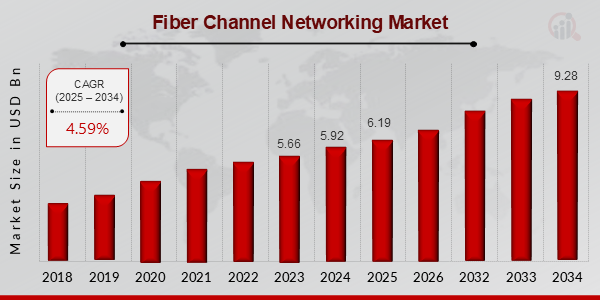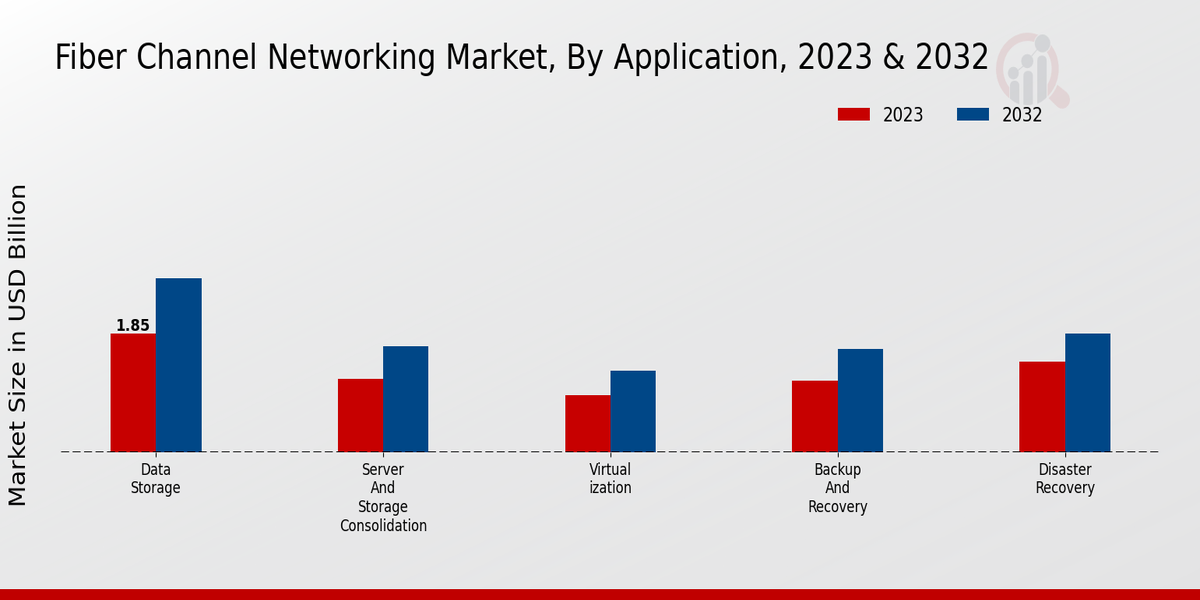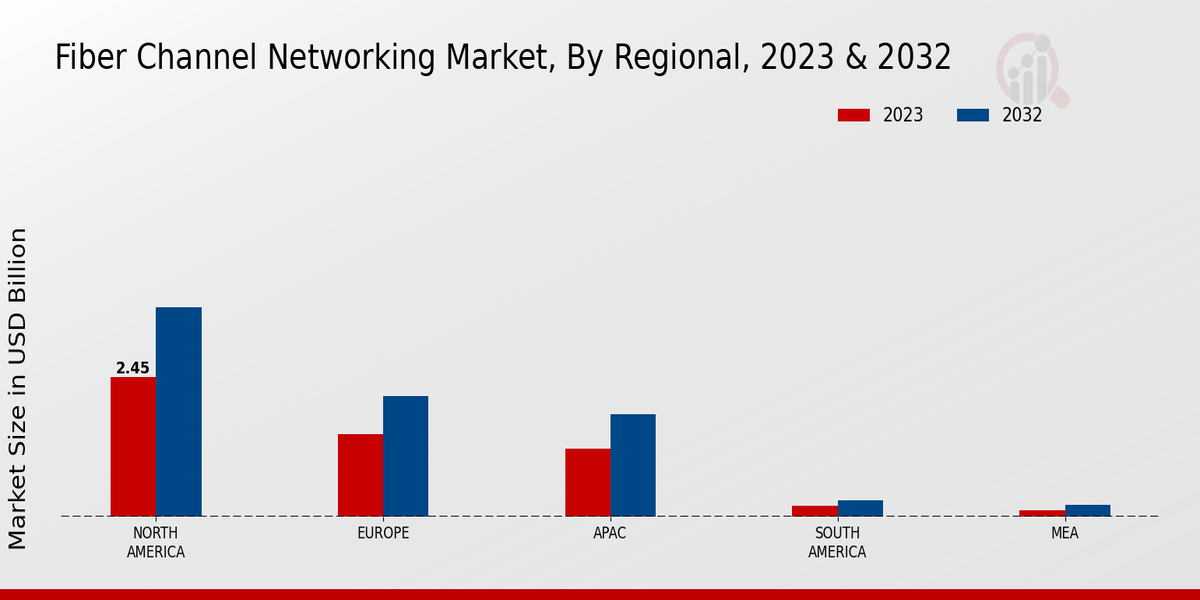Fiber Channel Networking Market Overview
Fiber Channel Networking Market is projected to grow from USD 6.19 Billion in 2025 to USD 9.28 Billion by 2034, exhibiting a compound annual growth rate (CAGR) of 4.59% during the forecast period (2025 - 2034). Additionally, the market size for Fiber Channel Networking Market was valued at USD 5.92 billion in 2024.
Key Fiber Channel Networking Market Trends Highlighted
The Fiber Channel Networking Market is currently influenced by several significant trends that shape its direction. Increased data traffic due to the growing reliance on cloud computing and big data analytics drives the demand for faster and more efficient networking solutions. As organizations seek to enhance their data storage capabilities and improve system performance, the adoption of fiber channel technology becomes critical. Advances in storage area networks (SANs) and heightened focus on data security further fuel the drive for robust fiber channel networking solutions. There are numerous opportunities waiting to be explored in this market.
As companies continue to invest in digital transformation, the need for advanced networking infrastructure becomes essential. Organizations can tap into emerging technologies like artificial intelligence and machine learning, which can optimize network performance and efficiency. Additionally, the rise of edge computing creates a demand for high-speed, reliable data transfer, positioning fiber channel networking as a key player in this space. Companies focusing on developing integrated solutions and offering managed services could further capitalize on these opportunities. Recent trends indicate an increasing shift towards automation and virtualization in network management.
Many organizations are looking to simplify their networking processes to enhance operational efficiency. The integration of software-defined networking (SDN) with fiber channel technology is gaining traction, allowing for more agile and adaptable network configurations. Furthermore, the emphasis on sustainable practices is leading to innovations in energy-efficient fiber channel products, appealing to environmentally conscious businesses. As the landscape evolves, organizations must stay attuned to these trends to leverage their full potential and maintain a competitive edge.
Fig 1: Fiber Channel Networking Market Overview

Source: Primary Research, Secondary Research, MRFR Database and Analyst Review
Fiber Channel Networking Market Drivers
Increasing Demand for High-Speed Data Transmission
The Fiber Channel Networking Market Industry is experiencing a significant surge in demand for high-speed data transmission solutions. As businesses strive to enhance their operational efficiencies and support an ever-growing volume of data, the need for fast and reliable connectivity has become paramount. Fiber Channel networking provides superior throughput capabilities, facilitating rapid data transfer between devices in densely populated data centers.
With the rise of cloud computing, big data analytics and Internet of Things (IoT) applications, organizations are increasingly reliant on swift data communication. This demand for speed and efficiency drives investments in fiber channel technologies, leading to enhancements in network infrastructure. As industries expand and evolve, the requirement for a robust infrastructure that can handle escalating data loads becomes critical. Furthermore, fiber channel solutions offer enhanced bandwidth and lower latency, making them ideal for environments that require real-time data processing and immediate access to critical information.
The trend of digital transformation across various sectors, including healthcare, finance, and telecommunications, further accentuates the need for efficient and high-performance networking solutions, positioning the Fiber Channel Networking Market for sustained growth. Companies are adopting advanced fiber channel technologies to improve not only their data transmission capabilities but also their overall operational effectiveness, thereby prompting a long-term investment in the sector.
Rapid Growth of Data-Driven Applications
With the rapid growth of data-driven applications across various industries, the Fiber Channel Networking Market Industry is witnessing a significant uptick in demand for efficient networking solutions. Businesses are increasingly leaning towards applications that require substantial amounts of data processing in real-time, necessitating the implementation of robust networking infrastructure. This trend is especially pronounced in sectors like finance, healthcare, and e-commerce, where rapid data access is pivotal for decision-making and operational agility.As more organizations embrace data analytics, machine learning, and artificial intelligence, the reliance on fiber channel networking technology becomes critical to support these demanding applications.
Increased Adoption of Virtualization Technologies
The migration towards virtualization technologies is another key driver of growth in the Fiber Channel Networking Market Industry. As enterprises adopt virtualization to maximize resource utilization and enhance accessibility, the need for networking solutions that can efficiently support virtualized environments becomes evident. Fiber Channel technology offers the necessary bandwidth and reliability to facilitate seamless connectivity for virtual machines and storage arrays.This shift towards a more dynamic IT infrastructure fosters a demand for advanced fiber channel networking capabilities, thereby supporting the expansion of this market segment.
Fiber Channel Networking Market Segment Insights
Fiber Channel Networking Market Application Insights
The Fiber Channel Networking Market is witnessing notable growth, driven largely by advancements in technology and increasing data management needs across various industries. As of 2023, this market is valued at 5.42 USD Billion, reflecting the expanding demand for efficient networking solutions. Within the broader market landscape, the Application segment plays a crucial role, comprising several key areas that contribute significantly to the overall market dynamics. Among these, Data Storage emerges as a leader with a valuation of 1.85 USD Billion in 2023, and it is projected to grow to 2.72 USD Billion by 2032. This growth is underpinned by the increasing need for secure and scalable data storage solutions as businesses generate massive amounts of data every day. Following closely is Server and Storage Consolidation, valued at 1.14 USD Billion in 2023; this area fosters efficiency by centralizing resources, which is essential for reducing operational costs and enhancing performance.
Virtualization is also gaining traction, valued at 0.89 USD Billion, reaching 1.27 USD Billion by 2032, as organizations aim to optimize their hardware resources through virtual platforms, thus streamlining their operations. Backup and Recovery, with a valuation of 1.12 USD Billion in 2023, also remains vital, ensuring data integrity and availability in the face of disasters, which has become increasingly critical in today's risk-prone business environment. Disaster Recovery, valued at 1.42 USD Billion, rounds out the Application segment, highlighting its importance as businesses prioritize continuity planning and infrastructural resilience amidst growing cyber threats and natural disasters.
The cumulative insights from the Application segment illustrate distinct trends, as each area addresses specific challenges faced by organizations. Data Storage and Backup and Recovery are particularly significant as they hold majority shares in meeting data security and access needs, while Virtualization offers a growing avenue for resource optimization. The increasing integration of these applications demonstrates their relevance in a digital-first landscape, further solidifying their positions within the Fiber Channel Networking Market. The overall market growth is driven by the increasing reliance on data-driven decision-making, the necessity of IT resource optimization, and the urgency for robust disaster recovery solutions amidst a rising tide of cyber risks, thereby creating substantial opportunities across all applications.
Overall, the Fiber Channel Networking Market segmentation emphasizes a balanced approach to technology deployment, with each application working in concert to meet the evolving demands of the industry.
Fig 2: Fiber Channel Networking Market Insights

Source: Primary Research, Secondary Research, MRFR Database and Analyst Review
Fiber Channel Networking Market End User Insights
The end-user segment is pivotal for driving growth within the market, encompassing various industries, including IT and telecommunications, BFSI, healthcare, government and manufacturing. Notably, the IT and telecommunications sector possesses a significant influence due to its reliance on high-speed data transfer and storage solutions, facilitating increased efficiency and connectivity. Similarly, the BFSI sector also plays a crucial role, as secure and fast data transmission is essential for financial transactions and information management.
Healthcare is emerging as a critical segment, focusing on data integrity and security in patient information management. The government sector's need for secure, high-volume data transfer supports market stability. Manufacturing also contributes substantially to the Fiber Channel Networking Market statistics, as optimized data exchange is necessary for enhancing operational efficiency and productivity. As these sectors continue to evolve and expand, they present considerable opportunities for growth and innovation within the market, underpinning its overall importance.
Fiber Channel Networking Market Solution Type Insights
Solution Type segmentation, comprising Hardware, Software and Services. As the demand for high-speed data transfers and robust network security continues to rise, the Hardware segment plays a pivotal role by providing essential components such as switches, routers, and storage devices. The Software segment enhances network efficiency and management, becoming increasingly vital as businesses seek to streamline operations and maximize performance.
Additionally, the Services aspect ensures proper implementation and maintenance, fostering reliable network environments. Collectively, these components are crucial for fulfilling the diverse requirements of various industries, contributing to the overall market growth and development amidst evolving technological landscapes. With the surge in data-centric applications and enterprise expansion, the Fiber Channel Networking Market data shows promising prospects for these Solution Types, supported by ongoing advancements and increased investments in network infrastructure.The industry's ability to adapt and innovate further positions it to tackle emerging challenges and seize new opportunities for growth.
Fiber Channel Networking Market Network Type Insights
Among its various Network Type offerings, Fibre Channel over Ethernet (FCoE) and Fibre Channel only are significant contributors to the market's landscape. FCoE is gaining traction due to its ability to consolidate storage and LAN networks, providing flexibility in architecture, while Fibre Channel only maintains a robust position due to its proven reliability and stability in high-performance environments.This diversification within the Fiber Channel Networking Market segmentation caters to various end-user needs, driving both innovation and adoption across industries such as IT and telecommunications. Market statistics suggest that the development of cloud computing and big data analytics will further bolster the need for swift and dependable connectivity, creating opportunities for both segmentation areas. However, challenges such as high implementation costs and technical complexities may hinder growth in some regions. Overall, the Fiber Channel Networking Market data showcases a steady trajectory, supported by the increasing reliance on network solutions.
Fiber Channel Networking Market Regional Insights
The Regional segment of the Fiber Channel Networking Market holds significant financial value, with North America leading at 2.45 USD Billion in 2023 and projected to grow to 3.68 USD Billion by 2032, indicating its dominant position in the market. Europe follows, valued at 1.45 USD Billion in 2023 and expected to reach 2.12 USD Billion by 2032, showcasing a steady growth trend due to increasing demand for high-speed data transfer solutions. APAC, with a valuation of 1.2 USD Billion in 2023, is anticipated to grow to 1.8 USD Billion, reflecting the region's rapid industrialization and technological advancement.
South America and MEA represent the smaller segments, with South America valued at 0.2 USD Billion and MEA at 0.12 USD Billion in 2023, growing to 0.3 USD Billion and 0.22 USD Billion respectively. The majority holding of North America and Europe indicates their critical role in innovation and infrastructure development within the Fiber Channel Networking Market. Growth drivers in these regions include the rise in data centers and cloud services, while opportunities such as advancements in fiber optic technology present potential for further market expansion.However, challenges like economic instability in regions such as MEA may hinder progress. The Fiber Channel Networking Market revenue is consequently shaped by varying dynamics across these regional markets.
Fig 3: Fiber Channel Networking Market Regional Insights

Source: Primary Research, Secondary Research, MRFR Database and Analyst Review
Fiber Channel Networking Market Key Players and Competitive Insights
The Fiber Channel Networking Market has seen significant advancements driven by the increasing demand for high-speed data transmission, particularly within data centers and enterprise IT environments. As organizations strive for seamless connectivity, the market is characterized by robust competition among several key players, each vying to offer innovative solutions that cater to diverse client needs. This growing demand is not only fostering technological innovation but also leading to strategic partnerships and collaborative efforts among market participants. Companies are increasingly focusing on enhancing the functionality and performance of Fiber Channel solutions, while also exploring cost-effective alternatives to maintain a competitive edge in this rapidly evolving landscape. The presence of numerous established players, alongside emerging organizations, contributes to a competitive atmosphere filled with opportunities and challenges that shape the market's trajectory.
Hewlett Packard Enterprise stands out within the Fiber Channel Networking Market due to its extensive product portfolio and strong market presence. As a leader in IT solutions, the company has developed innovative Fiber Channel networking offerings that cater to a wide range of business requirements. HPE leverages its deep industry expertise and research capabilities to design high-performance and scalable networking equipment, which has been critical for enterprises looking to enhance their data management and storage solutions. The company's holistic approach to technology integration, combined with its commitment to delivering reliable customer support, has positioned it favorably in the market. Additionally, HPE’s focus on creating flexible and adaptable networking solutions enables clients to efficiently manage their digital transformation initiatives, thereby reinforcing its stronghold in the Fiber Channel space.
Arista Networks is another significant player in the Fiber Channel Networking Market, recognized for its cutting-edge technology and robust network solutions tailored for cloud computing and data centers. The company has established itself as a major competitor by offering high-performance switching solutions that emphasize low latency and reliability, critical for Fiber Channel networking applications. Arista's products are designed to meet the evolving needs of modern enterprises seeking efficient data processing capabilities. The company's commitment to continuous innovation is evident through its investment in research and development, allowing it to deliver state-of-the-art networking solutions that align with industry standards and customer expectations. Arista Networks has built a reputation for excellence by providing a high level of service and support, thus enhancing customer satisfaction and loyalty within the Fiber Channel Networking Market.
Key Companies in the Fiber Channel Networking Market Include
Fiber Channel Networking Market Industry Developments
The Fiber Channel Networking Market has witnessed several significant developments recently. Hewlett Packard Enterprise has announced advancements in its storage solutions, enhancing data center performance and integration capabilities. Arista Networks is also expanding its portfolio, particularly focusing on high-speed networking solutions that cater to cloud and data-centric environments. Meanwhile, Cisco Systems is intensifying its efforts to promote increased network security across its fiber channel offerings.
Notably, there have been recent mergers and acquisitions, including IBM's acquisition of a data analytics firm that bolsters its networking capabilities, along with Broadcom's strategic moves to strengthen its semiconductor solutions relevant to Fiber Channel technologies. Growth in market valuations is seen with companies like Dell Technologies and NetApp experiencing robust demand for efficient network management and high-performance computing. This surge is influencing the overall market dynamics, pushing firms to innovate rapidly and align with evolving customer needs in data connectivity and storage solutions. The competitive landscape is becoming increasingly vibrant as organizations navigate technological advancements and expand their service offerings.
Fiber Channel Networking Market Segmentation Insights
Fiber Channel Networking Market Application Outlook
- Data Storage
- Server and Storage Consolidation
- Virtualization
- Backup and Recovery
- Disaster Recovery
Fiber Channel Networking Market End User Outlook
- IT and Telecommunications
- BFSI
- Healthcare
- Government
- Manufacturing
Fiber Channel Networking Market Solution Type Outlook
- Hardware
- Software
- Services
Fiber Channel Networking Market Network Type Outlook
- Fibre Channel over Ethernet
- Fibre Channel only
Fiber Channel Networking Market Regional Outlook
- North America
- Europe
- South America
- Asia Pacific
- Middle East and Africa
|
Report Attribute/Metric
|
Details
|
|
Market Size 2024
|
5.92 (USD Billion)
|
|
Market Size 2025
|
6.19 (USD Billion)
|
|
Market Size 2034
|
9.28 (USD Billion)
|
|
Compound Annual Growth Rate (CAGR)
|
4.59% (2025 - 2034)
|
|
Report Coverage
|
Revenue Forecast, Competitive Landscape, Growth Factors, and Trends
|
|
Base Year
|
2024
|
|
Market Forecast Period
|
2025 - 2034
|
|
Historical Data
|
2019 - 2023
|
|
Market Forecast Units
|
USD Billion
|
| Key Companies Profiled |
Hewlett Packard Enterprise, Arista Networks, QLogic, Cisco Systems, Huawei, Emulex, Chenbro, ATTO Technology, IBM, Mellanox Technologies, Dell Technologies, NetApp, Fujitsu, Broadcom, Extreme Networks |
| Segments Covered |
Application, End User, Solution Type, Network Type, Regional |
| Key Market Opportunities |
Increasing data storage needs, Adoption of cloud services, High-speed data transfer demand, Growth in AI and IoT, Expansion in data center infrastructure |
| Key Market Dynamics |
growing demand for data storage, increasing cloud adoption, rising need for high-speed connectivity, advancements in storage solutions, expanding enterprise IT infrastructure |
| Countries Covered |
North America, Europe, APAC, South America, MEA |
Frequently Asked Questions (FAQ) :
The Fiber Channel Networking Market was expected to be valued at 9.28 USD Billion by 2034.
The estimated CAGR for the Fiber Channel Networking Market from 2025 to 2034 is 4.59%.
North America is expected to dominate the Fiber Channel Networking Market, valued at 3.68 USD Billion by 2032.
The market value for the Data Storage application is expected to reach 2.72 USD Billion by 2032.
Key players in the Fiber Channel Networking Market include Hewlett Packard Enterprise, Cisco Systems, and IBM.
The anticipated market value for the Server and Storage Consolidation application is projected to be 1.66 USD Billion by 2032.
The expected market size for the Backup and Recovery application is projected to reach 1.61 USD Billion by 2032.
The market value for the APAC region is expected to be 1.8 USD Billion by 2032.
The expected market value for the Disaster Recovery application is anticipated to be 1.86 USD Billion by 2032.
The market value for Europe in 2032 is expected to be 2.12 USD Billion.

















